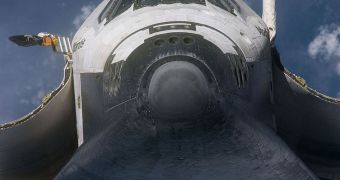The American space agency made public its plans to retire the space shuttles from active duty some time ago. Since then, the idea has been both criticized and praised by officials from NASA, the federal government, the media and space analysts. At the time of this article, the agency remains bent on retiring its three remaining shuttles by September 2010, on account of their own age. The major drawback of this measure, critics say, is the fact that the United States will be left without the capability to put astronauts in the Earth's orbit for the first time in the history of its space program, Discovery News reports.
Originally, the shuttles were designed to perform a lot more flights than they had until that point. However, experts at NASA have deemed it necessary to retire the spacecraft due to wear, and also to the fact that the agency will receive a lot less funds overall over the coming years. Officials at the Washington DC Headquarters say that they plan to use the funds to accelerate the development of Project Constellation, the successor of the space shuttles. The project is already behind schedule and over budget, but NASA is pressing on regardless. The shuttles have been in operation for 29 years.
Only five flights are currently scheduled for 2010. The first one will take place in February, when shuttle Endeavor will deliver a new module to the International Space Station (ISS). The module was known as Node 3, but was renamed Tranquility. Affixed to it will be a six-windowed dome known as the Cupola, which will make it easier for astronauts to handle the station's robotic arms. This is of great importance now, as the Japanese space agency, JAXA, has developed the HTV capsules, which need to be captured in mid-flight, as they have no automated docking capabilities.
Discovery will fly next, carrying tons of spare parts, which should suffice on the ISS until Project Constellation is up and running. NASA is currently working on gathering as many spare parts on the station as possible, as each shuttle can carry up to 50,000 pounds of cargo. Another Russian-built docking port and mini research module will be delivered in May aboard Atlantis. The event will also mark this shuttle's final flight. Endeavor will also complete its last mission in July, when it will carry physics experiments and additional tons of supplies to low-Earth orbit.
The final flight will take place in September, and will be carried out by Discovery. This STS mission will also be delivering supplies and new scientific experiments to the ISS. After this shuttle returns, the entire Program will most likely conclude, unless new developments take place. Another shuttle mission was proposed after the September one, most likely featuring Atlantis, but officials have yet to approve it, or allot funds for it.

 14 DAY TRIAL //
14 DAY TRIAL //